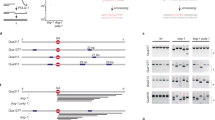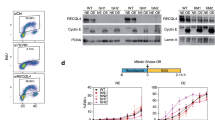Abstract
Bloom syndrome (BS) is a recessive human genetic disorder characterized by short stature, immunodeficiency and an elevated risk of malignancy. The gene mutated in BS, BLM, encodes a RecQ-type DNA helicase. BS cells have mutator phenotypes such as hyper-recombination, chromosome instability and an increased frequency of sister chromatid exchange (SCE). To define the primary role of BLM, we generated BLM−/− mutants of the chicken B-cell line DT40. In addition to characteristics of BLM−/− cells reported previously by the other group, they are hypersensitive to genotoxic agents such as etoposide, bleomycin and 4-nitroquinoline-1-oxide and irradiation with the short wave length of UV (UVC) light, whereas they exhibit normal sensitivity to X-ray irradiation and hydroxyurea. UVC irradiation to BLM−/− cells during G1 to early S phase caused chromosomal instability such as chromatid breaks and chromosomal quadriradials, leading to eventual cell death. These results suggest that BLM is involved in surveillance of base abnormalities in genomic DNA that may be encountered by replication forks in early S phase. Such surveillance would maintain genomic stability in vertebrate cells, resulting in the prevention of cellular tumorigenesis.
This is a preview of subscription content, access via your institution
Access options
Subscribe to this journal
Receive 50 print issues and online access
$259.00 per year
only $5.18 per issue
Buy this article
- Purchase on Springer Link
- Instant access to full article PDF
Prices may be subject to local taxes which are calculated during checkout





Similar content being viewed by others
References
Bezzubova OY and Buerstedde JM. . 1994 Experientia 50: 270–276.
Bezzubova O, Silbergleit A, Yamaguchi-Iwai Y, Takeda S and Buerstedde JM. . 1997 Cell 89: 185–193.
Buerstedde JM, Reynaud CA, Humphries EH, Olson W, Ewert DL and Weill JC. . 1990 EMBO J. 9: 921–927.
Buerstedde JM and Takeda S. . 1991 Cell 67: 179–188.
Courcelle J and Hanawalt PC. . 1999 Mol. Gen. Genet. 262: 543–551.
Davey S, Han CS, Ramer SA, Klassen JC, Jacobson A, Eisenberger A, Hopkins KM, Lieberman HB and Freyer GA. . 1998 Mol. Cell. Biol. 18: 2721–2728.
Dedon PC, Plastaras JP, Rouzer CA and Marnett LJ. . 1998 Proc. Natl. Acad. Sci. USA 95: 11113–11116.
Ellis NA, Groden J, Ye TZ, Straughen J, Lennon DJ, Ciocci S, Proytcheva M and German J. . 1995 Cell 83: 655–666.
Ellis NA, Proytcheva M, Sanz MM, Ye TZ and German J. . 1999 Am. J. Hum. Genet. 65: 1368–1374.
Galiegue-Zouitina S, Bailleul B and Loucheux-Lefebvre MH. . 1984 Anal. Biochem. 138: 454–457.
German J. . 1993 Medicine (Balt.) 72: 393–406.
Heartlein MW, Tsuji H and Latt SA. . 1987 Exp. Cell Res. 169: 245–254.
Henson P, Selsky CA and Little JB. . 1981 Cancer Res. 41: 760–766.
Heo SJ, Tatebayashi K, Ohsugi I, Shimamoto A, Furuichi Y and Ikeda H. . 1999 Genes Cells 4: 619–625.
Kadyk LC and Hartwell LH. . 1993 Genetics 133: 469–487.
Karow JK, Chakraverty RK and Hickson ID. . 1997 J. Biol. Chem. 272: 30611–30614.
Karow JK, Lia A, Constantinou JL, West SC and Hickson ID. . 2000 Proc. Natl. Acad. Sci. USA 97: 6504–6508.
Kitao S, Shimamoto A, Goto M, Miller RW, Smithson WA, Lindor NM and Furuichi Y. . 1999 Nat. Genet. 22: 82–84.
Krepinsky AB, Heddle JA and German J. . 1979 Hum. Genet. 50: 151–156.
Krepinsky AB, Rainbow AJ and Heddle JA. . 1980 Mutat. Res. 69: 357–368.
Kurihara T, Tatsumi K, Takahashi H and Inoue M. . 1987 Mutat. Res. 183: 197–202.
Kusano K, Berres ME and Engels WR. . 1999 Genetics 151: 1027–1039.
Langlois RG, Bigbee WL, Jensen RH and German J. . 1989 Proc. Natl. Acad. Sci. USA 86: 670–674.
Lindahl T. . 1990 Mutat. Res. 238: 305–311.
Lu J, Mullen JR, Brill SJ, Kleff S, Romeo AM and Sternglanz R. . 1996 Nature 383: 678–679.
Matsumoto L, Kurek K, Larocque K, Gustafson G, Pires R, Zhang J, Tantravahi U and Suggs JW. . 1999 Mutat. Res. 426: 79–87.
Mosmann T. . 1983 J. Immunol. Methods 65: 55–63.
Murray JM, Lindsay HD, Munday CA and Carr AM. . 1997 Mol. Cell. Biol. 17: 6868–6875.
Nakayama K, Irino N and Nakayama H. . 1985 Mol. Gen. Genet. 200: 266–271.
Onoda F, Seki M, Miyajima A and Enomoto T. . 2000 Mutat Res. 459: 203–209.
Puranam KL and Blackshear PJ. . 1994 J. Biol. Chem. 269: 29838–29845.
Ray JH and German J. . 1984 Chromosoma 90: 383–388.
Rosin MP and German J. . 1985 Hum. Genet. 71: 187–191.
Seki M, Miyazawa H, Tada S, Yanagisawa J, Yamaoka T, Hoshino S, Ozawa K, Eki T, Nogami M, Okumura K, Taguchi H, Hanaoka F and Enomoto T. . 1994 Nucleic Acids Res. 22: 4566–4573.
Shimamoto A, Nishikawa K, Kitao S and Furuichi Y. . 2000 Nucleic Acids Res. 28: 1647–1655.
Shiraishi Y. . 1985 EMBO J. 4: 2553–2560.
Smith GJ and Grisham JW. . 1983 Mutat. Res. 111: 405–417.
Sonoda E, Sasaki MS, Buerstedde JM, Bezzubova O, Shinohara A, Ogawa H, Takata M, Yamaguchi-Iwai Y and Takeda S. . 1998 EMBO J. 17: 598–608.
Sonoda E, Sasaki MS, Morrison C, Yamaguchi-Iwai Y, Takata M and Takeda S. . 1999 Mol. Cell. Biol. 19: 5166–5169.
Stewart E, Chapman CR, Al-Khodairy F, Carr AM and Enoch T. . 1997 EMBO J. 16: 2682–2692.
Sun H, Karow JK, Hickson ID and Maizels N. . 1998 J. Biol. Chem. 273: 27587–27592.
Suzuki N, Shimamoto A, Imamura O, Kuromitsu J, Kitao S, Goto M and Furuichi Y. . 1997 Nucleic Acids Res. 25: 2973–2978.
Takao N, Kato H, Mori R, Morrison C, Sonada E, Sun X, Shimizu H, Yoshioka K, Takeda S and Yamamoto K. . 1999 Oncogene 18: 7002–7009.
Tornaletti S and Pfeifer GP. . 1996 Bioessays 18: 221–228.
Wang Y, Cortez D, Yazdi P, Neff N, Elledge SJ and Qin J. . 2000a Genes Dev. 14: 927–939.
Wang W, Seki M, Narita Y, Sonoda E, Takeda S, Yamada K, Masuko T, Katada T and Enomoto T. . 2000b EMBO J. 19: 3428–3435.
Watt PM, Hickson ID, Borts RH and Louis EJ. . 1996 Genetics 144: 935–945.
Werner-Favre C, Wyss M, Cabrol C, Felix F, Guenin R, Laufer D and Engel E. . 1984 Am. J. Med. Genet. 18: 215–221.
Wood RD. . 1999 Biochimie 81: 39–44.
Yamagata K, Kato J, Shimamoto A, Goto M, Furuichi Y and Ikeda H. . 1998 Proc. Natl. Acad. Sci. USA 95: 8733–8738.
Yamaguchi-Iwai Y, Sonoda E, Sasaki MS, Morrison C, Haraguchi T, Hiraoka Y, Yamashita YM, Yagi T, Takata M, Price C, Kakazu N and Takeda S. . 1999 EMBO J. 18: 6619–6629.
Yu CE, Oshima J, Fu YH, Wijsman EM, Hisama F, Alisch R, Matthews S, Nakura J, Miki T, Ouais S, Martin GM, Mulligan J and Schellenberg GD. . 1996 Science 272: 258–262.
Acknowledgements
We thank Chie Itoh for her technical assistance. We also thank Eiichiro Sonoda and Minoru Takata at Kyoto University for their valuable technical advice. We would like to acknowledge Martin Lavin at Queensland Institute of Medical Research in Australia for critically reading the manuscript. We thank Nathan A Ellis for kindly providing plasmids for expression of wild-type and ATPase-defective HsBLMs. This work was supported by the Drug Organization supervised by the Ministry of Health and Welfare of the Japanese Government.
Author information
Authors and Affiliations
Rights and permissions
About this article
Cite this article
Imamura, O., Fujita, K., Shimamoto, A. et al. Bloom helicase is involved in DNA surveillance in early S phase in vertebrate cells. Oncogene 20, 1143–1151 (2001). https://doi.org/10.1038/sj.onc.1204195
Received:
Revised:
Accepted:
Published:
Issue Date:
DOI: https://doi.org/10.1038/sj.onc.1204195
Keywords
This article is cited by
-
Protein expression of BLM gene and its apoptosis sensitivity in hematopoietic tumor cell strains
Journal of Huazhong University of Science and Technology [Medical Sciences] (2008)
-
BLM helicase is activated in BCR/ABL leukemia cells to modulate responses to cisplatin
Oncogene (2005)
-
Disruption of the BLM gene in ATM-null DT40 cells does not exacerbate either phenotype
Oncogene (2004)
-
RecQ family helicases: roles as tumor suppressor proteins
Oncogene (2002)
-
Werner and Bloom helicases are involved in DNA repair in a complementary fashion
Oncogene (2002)



